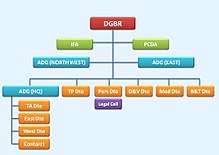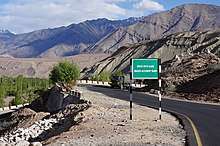Border Roads Organisation
The Border Roads Organisation (BRO) develops and maintains road networks in India's border areas and friendly neighboring countries. Officers from the Border Roads Engineering Service (BRES) and personnel from the General Reserve Engineer Force (GREF) form the parent cadre of the Border Roads Organisation. It is also staffed by officers and troops drawn from the Indian Army's Corps of Engineers on extra regimental employment (on Deputation). Currently, the organisation maintains operations in twenty-one states, one UT (Andaman and Nicobar Islands), and neighboring countries such as Afghanistan, Bhutan, Myanmar, and Sri Lanka. The BRO operates and maintains over 32,885 kilometers of roads and about 12,200 meters of permanent bridges in the country. Presently, BRO is also involved in the construction of a tunnel at the Rohtang pass which is estimated to be ready by 2020 September.
 BRO Logo | |
| Abbreviation | BRO |
|---|---|
| Motto | Shramena Sarvam Sadhyam (everything is achievable through hardwork)[1] |
| Formation | 7 May 1960 |
| Legal status | Active |
| Purpose | Civil engineering infrastructural development |
| Headquarters | New Delhi |
Region served | India, Bhutan, Nepal, Myanmar, Afghanistan |
Director General | Lt. Gen.Harpal Singh [2] |
Parent organisation | Ministry of Defence |
Budget | $ 732 million |
| Website | http://www.bro.gov.in/ |
| Remarks | · |
The BRO operates in 18 Projects namely: Arunank, Beacon, Brahmank, Chetak, Deepak, Dantak, Himank, Hirak, Pushpak, Sampark, Setuk, Sewak, Shivalik, Swastik, Udayak, Vartak, Vijayak and sela tunnel.[3]
History
The BRO was formed on 7 May 1960 to secure India's borders and develop infrastructure in remote areas of the north and north-east states of the country.[4] In order to ensure coordination and expeditious execution of projects, the Government of India set up the Border Roads Development Board (BRDB) with the Prime Minister as Chairman of the Board and Defence Minister as Deputy Chairman. Today, the board exercises the financial and other powers of a Department of Government of India and is chaired by the Raksha Rajya Mantri (RRM). Among others, Chief(s) of Army and Air Staff, Engineer-in-Chief, Director General Border Roads (DGBR), FA(DS) are members of the BRDB. The Secretary of the Board exercises the powers of Joint Secretary to the Government of India. The executive head of the BRO is the DGBR who holds the rank of Lieutenant General.[5] In a bid to boost border connectivity, the Border Roads Organisation has been entirely brought under the Ministry of Defence. Earlier it received funds from the Ministry of Road Transport and Highways.[6]
Organisation
The BRO consists of Border Roads Wing under the Ministry of Defense and the General Reserve Engineer Force (GREF). Officers are selected through the Indian Engineering Services (IES) Examination conducted by the Union Public Service Commission (UPSC). Few officers are also deputed from Indian Army Corps of Engineers, who are posted to GREF on ERE. The GREF includes Civil Engineers, Mechanical engineers, Administrative officers and Medical officers. The Border Roads Engineering Service (BRES) officers are governed by Central Civil Services (CCS/ CCA) Rules, 1965. They also subjected to all provisions of The Army Act, 1950 and Army Rules, 1954 except a few exceptions as given in SRO 329 and SRO 330 both 23 Sep 1960 . GREF is an integral part of the Armed Forces within meaning of Article 33 of The Constitution of India and members of GREF are also members of the Armed Forces as declared by Hon'ble Supreme Court in respect of R Viswan V/S Union of India 1983 and authorized for all benefits which are applicable to Armed Forces of India.

The organisation's operations are spread across India, Bhutan, Myanmar, Tajikistan, and Afghanistan.
Role of the BRO
During Peace
- To Develop & Maintain the Operational Road Infrastructure of General Staff (GS) in the Border Areas.
- To Contribute to the Socio-Economic Development of the Border States.
During War
- To Develop & Maintain Roads to Keep Line of Control through in Original Sectors and Re-deployed Sectors.
- To Execute Additional Tasks as laid down by the Govt Contributing to the War Effort.
BRO is entrusted for construction of Roads, Bridges, Tunnels, Causeways, Helipads and Airfields.
The BRO includes 18 projects, which are divided into Task Forces, Road Construction Companies (RCCs), Bridge Construction Companies (BCCs), Drain Maintenance Companies (DMCs), and Platoons. The organisation also includes base workshops, store divisions, training and recruitment centers, and other staff.[7]
The BRO is also in charge of maintenance of its road networks. In many places landslides, avalanches and snow block the routes and have to be cleared as quickly as possible. BRO also employs more than two lakh (200,000) Casual paid labours in the task.
An Internal Financial Advisor (IFA) supports the BRO, performing the roles of Chief Accounts Officer and Internal Auditor. This system was introduced on 23 March 1995 to introduce efficiency and improve resource utilisation.[8] The IFA secured ISO 9001 certification in December 1999.
Projects and initiatives
The BRO undertakes projects in India and friendly countries. These projects typically include developing roads, bridges, and airfields in hostile environments shunned by private enterprises, whether due to security concerns related to hostilities, or because of environmental challenges.
Disaster management and reconstruction
The BRO also played a vital role in reconstruction work in the aftermath of the devastating 2004 tsunami in Tamil Nadu, the 2005 Kashmir earthquake,[9] and the 2010 Ladakh flash floods.[10]
Overseas infrastructure development
Some of these projects carry out some of the development initiatives of the Indian government in foreign territories like Tajikistan, Afghanistan, Myanmar, and Bhutan. These include the Delaram-Zaranj Highway in Afghanistan, completed and handed over to the Afghan government during 2008,[11] and the restoration of the Farkhor[12] and Ayni[13] air bases in Tajikistan.
Border infrastructure development
In response to the ever-present security threat from Pakistan and increased incursions and rapid border infrastructure from China, India too is undertaking border infrastructure development.
Border roads
As per July 2017 update to Lok Sabha from the Government of India, construction of 73 completed strategic roads along the Sino-India border was approved in 2005 with an initial and currently revised deadlines of 2012-2013 and 2019-2020 respectively, including 43 by the Ministry of Defence and 27 by the Ministry of Home Affairs, of which only 21 roads by March 2017 and 30 roads by July 2017 have been completed and remaining are under construction as progress was slowed down due to wildlife conservation and environmental approval, insurgency related security hurdles, delay in land acquisition by the states, inaccessible terrain, inclement weather, etc. BRO is constructing 63 out of these 73 roads as it costs BRO ₹15 million (equivalent to ₹17 million, US$240,000 or €220,000 in 2019) to ₹30 million (equivalent to ₹34 million, US$470,000 or €440,000 in 2019) per km compared to ₹60 million (equivalent to ₹68 million, US$950,000 or €870,000 in 2019) to ₹70 million (equivalent to ₹79 million, US$1.1 million or €1.0 million in 2019) per km of road construction by the private companies.[14][15] In two years alone, 2015–16 and 2016–17, prime minister Narendra Modi's government has allocated more than US$4.7 billion in contracts for the development of border roads, which also includes the US$256 million 1,360 kilometres (850 mi) India–Myanmar–Thailand Trilateral Highway from Moreh in Manipur through Tamu, Myanmar to Mae Sot in Thailand.[16]
Road bridges
To provide multiple points of alternative connectivity to the forces, BRO is building 410 2-lane class-70 (heavy load bearing including tanks) road bridges along the 3,440 km long McMahon Line border with China, including 144 in Arunachal Pradesh (75 already under construction and will be completed by 2020), 100 under construction in Jammu and Kashmir, 55 under construction in Uttrakhand, 40 under construction in Sikkim and 25 under construction in Himachal Pradesh (c. Dec 2017).[17] The annual pace of construction is 3 km of bridges (c. Dec 2017).[17]
Tunnels
In November 2017 BRO announced the plan to construct 17 road and rail tunnels, with a total length of 100 km, on some of the 73 strategic roads on Sino-Indian border to provide the year-round all-weather rail and road surface connectivity. Currently, surface access to high altitude posts on Sino-India border is closed for six months every year due to snowfall and rain, and supplies are through air lift only. Some of these 17 tunnels are already under construction, including Srinagar-Kargil-Leh NH1 in J&K (Zoji La pass tunnel), Leh-Manali Highway in J&K and Himachal Pradesh (Lungalacha La, Bara-lacha la, Tanglang La, Shingo La near Nimo and Rohtang Tunnel), 578 meter Theng Pass tunnel on NH310A between Chungthang and Tung in North Sikkim, Nechipu Pass (near Bomdila) and Sela Pass tunnels on Bogibeel Assam to Sagalee to Tawang NH13 in Arunachal Pradesh. This will reduce the travel time and operational costs, eliminate the risk of avalanche and landslide.[18][19]
Issues
The organisation employs laborers locally. No local laborer is deployed in BRO for more than 179 days at a stretch, thus keeping the nature of their employment casual.[20]
See also
- Project HIMANK
- Indian Army Corps of Engineers
- Trans-Arunachal Highway
- Mago-Thingbu to Vijaynagar Border Road
- Chota Char Dham Railway
References
- "Inherent Strengths". Border Roads Organisation. Border Roads Organisation. Speed, Economy and quality. Archived from the original on 21 September 2010. Retrieved 25 September 2010.
- http://www.bro.gov.in/dgmessage.asp?lang=1
- "Lieutenant General Suresh Sharma takes over as Director General Border Roads (DGBR)". Press Information Bureau, Government of India, Ministry of Defence. 2016. Retrieved 6 January 2016.
- "Border Roads Organisation". GlobalSecurity.org. Alexandria, Virginia: GlobalSecurity.org. Retrieved 25 September 2010.
- "DG's Message". Border Roads Organisation. Border Roads Organisation. Archived from the original on 26 May 2011. Retrieved 20 May 2011.
- "Border Roads Organisation to be brought exclusively under Defence Ministry: Parrikar". Border Roads Organisation. Border Roads Organisation. Retrieved 31 December 2014.
- "Organisation Chart". Border Roads Organisation. Border Roads Organisation. Archived from the original on 27 July 2010. Retrieved 25 September 2010.
- Mohan, Devendra, IFA System in Lower Formations of Border Roads Organisation, Pune, India: National Academy of Defence Financial Management, Mindistry of Defence, Government of India, archived from the original (Microsoft Word) on 19 June 2009, retrieved 25 September 2010
- "Work in progress to restore vital border road". Outlook India. New Delhi: Outlook Publishing (India). 24 October 2005. Archived from the original on 30 January 2013. Retrieved 25 September 2010.
- Watts, Archit (15 September 2010). "Five weeks after floods, Leh-Manali road opens". Chandigarh Tribune. Chandigarh, India: The Tribune Trust. Retrieved 25 September 2010.
- Pubby, Manu (23 January 2009). "India hands over Afghan road, trade can now flow via Iran". The Indian Express. New Delhi: The Indian Express Online Media. Retrieved 25 September 2010.
- "India to deploy MiG-29 fighters at Tajikistan base". Monsters and Critics. Indianapolis: WOTR. 20 April 2006. Archived from the original on 30 September 2008. Retrieved 25 September 2010.
- Bedi, Rahul (20 September 2007). "India may have to quit Tajik military 'base'". Monsters and Critics. Indianapolis: WOTR. Archived from the original on 23 September 2011. Retrieved 25 September 2010.
- "73 roads of operational significance being built along China border: Kiren Rijiju", The Economic Times, 18 July 2017.
- Sushant Singh, "China border roads hobbling, 12 years later, 21 of 73 ready", Indian Express, 11 July 2017.
- "China's Silk Road lends urgency to India's regional ambitions.", Economic Times, 9 August 2017.
- India building bridges in Arunachal for LAC access, Economic Times, 18 Dec 2017.
- "For year-round border security, India plans tunnels on China border.", Economic Times, 6 November 2017.
- "Voyants bagged Independent Engineer Services in Arunachal Pradesh"
- Panghat, Brig (4 February 2005). "GREF not Industry governed by Industrial Dispute Act". Daily Excelsior. Jammu, India. Archived from the original on 3 May 2006. Retrieved 25 September 2010.
